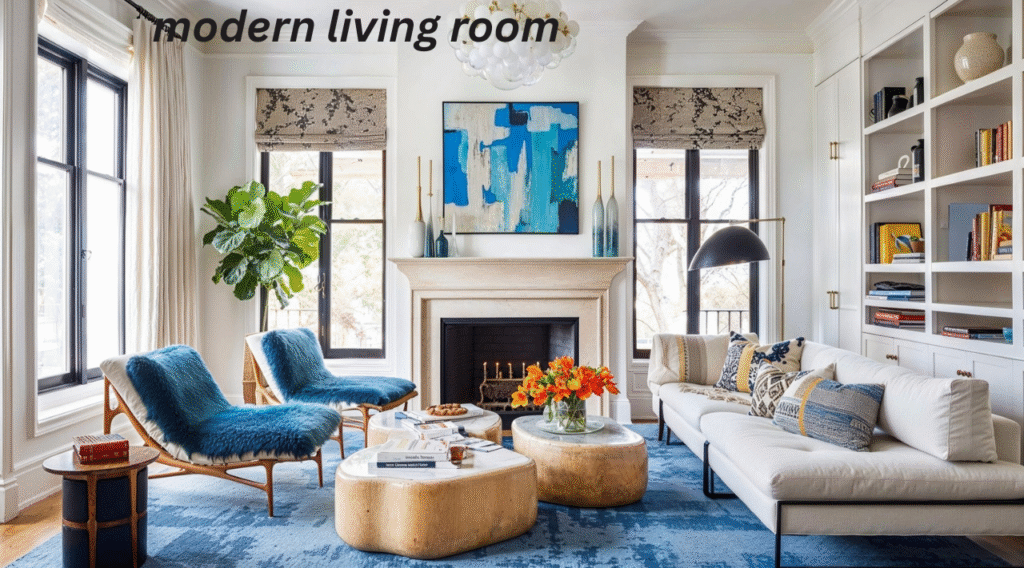The modern living room has become more than just a place to entertain guests; it is now the central hub of the home. Whether it’s watching your favorite series, working remotely, or simply relaxing with family, the living room plays a pivotal role in everyday life. As homes evolve to meet the demands of a fast-paced world, so too has the concept of modern design. Characterized by simplicity, functionality, and elegance, modern living room s bring together aesthetic charm and practical use in a single, cohesive space.
In this article, we explore what makes a living room truly modern, the latest design elements you can incorporate, and how to choose the right furniture, color schemes, and layout to suit your lifestyle. Whether you’re revamping an old setup or starting from scratch in a new home, these tips will help you achieve a stylish, modern living space that reflects your personality and meets your daily needs.
Defining the Modern Living Room AestheticModernLivingRoom

Key Characteristics of Modern Design
Modern living room design is deeply rooted in the principles of minimalism, balance, and harmony. It emphasizes clean lines, uncluttered spaces, and an open floor plan that allows for easy flow and natural light. The furniture pieces are often low-profile and made with materials like wood, leather, metal, and glass, which contribute to a sense of openness and airiness. Functionality is at the core of every decision—from the placement of furniture to the use of multi-purpose pieces that reduce clutter.
One key feature of modern design is its use of a neutral color palette, often punctuated with bold accents. Think greys, whites, and beiges paired with splashes of navy, mustard, or even emerald green. This approach creates a serene environment that’s easy to adapt over time. Moreover, modern design avoids ornate detailing, favoring instead smooth surfaces and straight edges that contribute to a streamlined look.
Differences Between Modern, Contemporary, and Minimalist Styles
While often used interchangeably, modern, contemporary, and minimalist styles have subtle but significant differences. Modern design is rooted in the early to mid-20th century, defined by a specific historical aesthetic and consistent design rules. Contemporary design, on the other hand, is fluid and ever-evolving—it reflects the current trends and often borrows elements from various styles, including modern and minimalist.
Minimalist design is a subset of modern design, taking the concept of “less is more” to its extreme. It strips down every element to its bare essentials, focusing on utility and simplicity. While a modern living room might have a few bold decorative pieces and a mix of textures, a minimalist one will limit decor to what is absolutely necessary.
Understanding these differences helps homeowners choose a style that aligns with their personal taste while ensuring consistency throughout their living space. Blending these styles is also possible—for instance, incorporating minimalist furniture within a modern living room to enhance space and light.
Essential Furniture for a Modern Living Room
Sofas and Sectionals
Sofas are the anchor of any living room, and in modern design, they serve both aesthetic and practical functions. The ideal modern sofa is low-profile, with clean lines and an understated elegance. Upholstery often features neutral shades, though adding a pop of color through throw pillows or textured fabrics can introduce a layer of visual interest. Materials such as leather, tweed, or eco-friendly fabrics are frequently chosen for their durability and sleek appeal.
Modular sectionals are particularly popular in modern spaces because they offer flexibility in arrangement and maximize seating. Whether you have a large open space or a compact room, sectionals can be configured to suit your needs. Features like built-in storage or recliners can enhance the utility of your sofa without compromising style.
Coffee Tables and Side Tables
In modern living rooms, coffee and side tables are more than just surfaces—they’re design statements. Geometric shapes, glass tops, and mixed materials such as marble and metal are common in contemporary coffee tables. These pieces help tie the room together while maintaining a minimalist aesthetic.
For functionality, look for tables with hidden storage compartments or nesting capabilities. Side tables should complement the coffee table and offer easy access to essentials like lighting, books, or remote controls. Together, these pieces create a cohesive environment that supports both form and function.
Storage and Media Units
Clutter is the enemy of modern design, making thoughtful storage solutions essential. Media consoles, wall-mounted shelves, and built-in cabinetry provide the storage needed for electronics, books, and decorative items. Sleek designs with hidden compartments allow for a tidy look while maintaining easy access to everyday items.
Floating units, in particular, are a hallmark of modern interiors. They create the illusion of more space and lend a contemporary touch to the room. Pair these with minimalist handles or push-to-open mechanisms for a seamless, streamlined appearance.
Color Palettes, Textures, and Décor Accents
Modern Color Schemes
A neutral color palette serves as the foundation of modern design. Whites, greys, and beiges provide a calming and sophisticated backdrop that allows for versatility in decorating. To avoid monotony, consider adding a bold accent color through accessories, artwork, or a statement piece of furniture.
Trending color pairings in modern living rooms include monochrome themes with pops of mustard yellow, deep teal, or rust. These hues can evoke emotion and personality without overwhelming the space. Painting an accent wall or incorporating color through textiles like rugs and cushions is a great way to keep things fresh and stylish.
Texture Play: Fabrics, Finishes, and Flooring
Texture adds depth and interest to a modern living room. A combination of soft and hard surfaces helps maintain visual balance. Pair a leather sofa with a wool throw, or contrast a sleek coffee table with a plush area rug. Layering different textures can transform a plain room into a rich, inviting environment.
Flooring choices also play a critical role. Hardwood, polished concrete, and large-format tiles are popular for their durability and visual appeal. Add warmth with area rugs that introduce color and pattern while defining different zones in an open-plan layout.
Art, Lighting, and Accessories
Modern living rooms are not devoid of personality; they simply showcase it in intentional ways. Abstract art, oversized prints, and sculptural pieces can act as focal points. When selecting artwork, opt for pieces that complement the room’s color scheme and add emotional resonance.
Lighting is equally important. Combine natural light with statement lighting fixtures such as pendant lamps, LED track lights, or floor lamps. Smart lighting systems that allow you to adjust brightness and color temperature can elevate the comfort and ambiance of your space. Lastly, accessories should be curated carefully—think decorative trays, coffee table books, and a few lush indoor plants to bring life into the room.
Designing for Functionality and Lifestyle
Layouts for Different Room Sizes
Whether your living room is compact or expansive, layout planning is crucial to maximizing functionality and comfort. In small spaces, opt for multi-purpose furniture and open shelving to reduce visual clutter. Use rugs and lighting to delineate areas, making the room feel more organized and spacious.
For larger rooms, create distinct zones for different activities, such as a reading corner, media area, and social seating. Anchor each zone with a rug and arrange furniture to facilitate conversation and traffic flow. Avoid pushing all furniture against the walls—floating pieces in the center can create intimacy and improve flow.
Tech Integration in the Modern Living Room
Modern living rooms embrace technology without allowing it to dominate the space. Built-in speakers, smart TVs, and hidden cables help maintain a clean look. Consider using a media console with cord management systems, or even concealing your TV behind art or cabinetry when not in use.
Smart home integration can also enhance convenience. Automated lighting, climate control, and voice-activated devices can be subtly integrated into the room. The key is to prioritize usability while maintaining the aesthetic integrity of the space.
Sustainability and Eco-Friendly Choices
Sustainable living is becoming an essential consideration in modern interior design. Opt for furniture made from responsibly sourced wood or recycled materials. Choose low-VOC (volatile organic compound) paints and finishes to improve indoor air quality.
Energy-efficient lighting, such as LED bulbs or solar-powered options, reduces your carbon footprint while lowering electricity bills. Adding plants not only enhances decor but also contributes to a healthier indoor environment by purifying the air and boosting mood.
Conclusion
Designing a modern living room is all about finding the right balance between style, comfort, and functionality. With clean lines, thoughtful furniture choices, and curated accessories, you can create a space that reflects your personal taste while meeting the demands of modern life. Remember, a modern space doesn’t mean a cold or impersonal one—with the right elements, it can be warm, welcoming, and uniquely yours.
FAQs
What colors work best in a modern living room?
Neutral shades like white, grey, and beige form the base, while accent colors like teal, mustard, or navy add personality.
How do I make a small living room look modern and spacious?
Use multi-functional furniture, light colors, and strategic lighting to open up the space visually.
Can I mix modern design with other styles like boho or farmhouse?
Yes, blending styles like modern-boho or modern-farmhouse is popular. The key is consistency and balance.
What are the best materials for modern living room furniture?
Wood, metal, leather, and glass are commonly used for their durability and sleek aesthetic.
How do I incorporate smart home features without ruining the design?
Use hidden wiring, smart plugs, and sleek devices to maintain a clean and cohesive look.
You May Also Read: https://zibbusiness.com/julie-pitt-neal/



